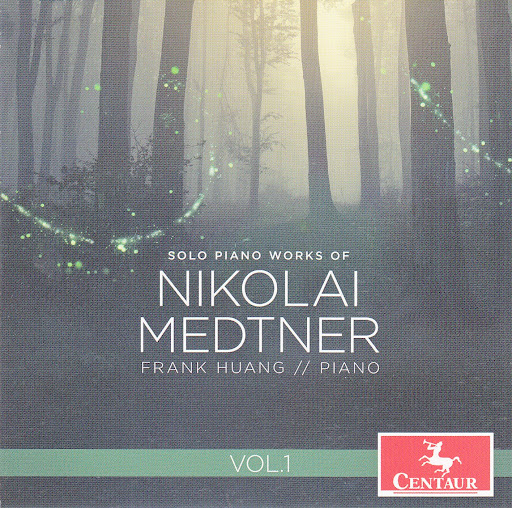by Mike Telin

With the release of the first of his nine-disc recording project of the Russian Romantic composer’s works for solo piano on the Centaur Records label, Frank Huang leaves you anticipating the next eight with adroit performances of three of Medtner’s beguiling compositions.
The recording also leaves you asking yourself why Medtner’s music isn’t programmed more often.
In the liner notes, Huang, a Steinway Artist who serves as an Associate Professor of Piano at Miami University in Oxford, Ohio, attributes Medtner’s relative obscurity on the concert stage to the fact that “the composer viewed writing and performing music as a sense of duty, almost like a sacrosanct calling.” Medtner also disliked marketing and self-promotion as well as performing music of other composers, which Huang says “seemed to limit his career growth — even with the aid of Rachmaninoff, who helped arrange a U.S. concert tour for him in 1924.”
Huang introduces listeners to Medtner’s music with a richly hued, pristine performance of the young composer’s first published work, Eight Mood Pictures.
During the Prologue (inspired by Mikhail Lermontov’s poem The Angel) the pianist proves himself to be a technically skillful and sensitive musician, paying close attention to the melodic lines.
Huang basks in the melodic material of the solemn march in No. 3, Maestoso freddo, and makes easy work of the sweeping phrases of No. 4, the lilting and sweet Andantino con moto.
In No. 5, Andante, inspired by another Lermontov poem, this one depicting a snowstorm, Huang nimbly tosses off the movement’s fancy filigree, while he highlights the concluding Allegro con grazia (quasi valse) with crisp, clear articulations.
Written in 1928, Medtner’s Op. 51 Six Fairytales showcase the composer’s more mature style. Depicting the Russian folk characters Zolushka (Cinderella) and Young Ivan the Fool, Huang brings a clean, focused sound to the percussive, quick mood changes of the opening movement.
The third movement, Allegretto tranquillo e grazioso, is music that grabs your attention, and the pianist brings a wealth of emotion to his performance, as he does during the concluding “Dance of the Fool.”
Composed in 1919-1920 and published in 1922, the Forgotten Melodies II, Op. 39, consist of five pieces that are introspective, brooding, and ultimately exultant.
Beginning with low, repeated notes, the “Meditation: Introduzione, quasi Cadenza” gradually grows into a disturbed serenity that continues into the following “Romance.” The music takes on a lighter feeling in “Spring,” transforming into the tranquil “Morning Song.” The final piece, “Tragic Sonata,” which at 10:40 is the longest piece on the album, imaginatively recalls the melodic and thematic material from the opening Meditation, bringing Op. 39 and the album to a grand conclusion.
Throughout the work, Huang once again proves himself to be an impressive interpreter who finds and reveals the inner workings of Medtner’s complex music rather than imposing himself on it. This attribute again results in a performance that allows the simple melodies to soar above heavily scored, rich harmonic lines.
Whether you are already a fan of Nikolai Medtner, or you’re hearing his music for the first time, this recording deserves a spot in your playlist.
Solo Piano Works of Nikolai Medtner, Volume 1, is available on Spotify, Apple Music, and Amazon.
Published on ClevelandClassical.com September 29, 2021.
Click here for a printable copy of this article


